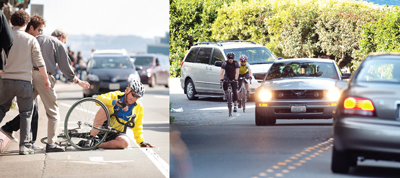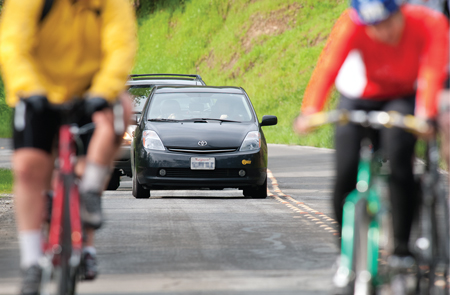Emerging from the fog of a coma last September, Monique Petrov had a number of questions. Where am I? Who put this tube down my throat? Did I get hit during the Ironman?
Four days earlier, the 40-year-old Petrov had set out on an all-afternoon bike ride. A well-known fitness coach and trainer in the Bay Area, she was also an elite triathlete preparing for the upcoming Ironman in Hawaii.
Five hours and 15 minutes after leaving her San Rafael home, Petrov was pushing 25 miles an hour, nudged along by a slight tailwind as she powered east on Lucas Valley Road. “I remember thinking, ‘I’ve done my work,’” she says. “‘I’m as prepared as I can be.’” She was five miles from home. She was in the bike lane.
That made no difference to the driver of the westbound minivan who turned off Lucas Valley onto Canyon Oak Drive. The driver later told police the sun blinded him and he did not see Petrov, who shattered his windshield upon impact, then landed 30 feet away on the shoulder of Canyon Oak, which had been recently grooved for re-paving. Stamped permanently on Petrov’s left forearm is a bar code of scars that correspond precisely to those grooves.
Those cuts were the least of her problems. Her left ulna, the bone beneath those scars, required reconstructive surgery, as did her wrecked right knee, which was impaled by her handlebar. Four ribs broke; one punctured her left lung, causing it to fill with blood. Her left shoulder blade snapped in two. Six vertebrae cracked and a seventh — her sixth thoracic — simply “burst,” as her neurosurgeon, Dr. Peter Nguyen, put it. During an 18-hour operation, Nguyen rebuilt and reinforced the shattered vertebra with screws, rods, shavings from one of Petrov’s broken ribs and a piece of tibia from a cadaver. In a 90-minute interview, tears filled Petrov’s eyes only once, when she talked about the job done by Nguyen and his team.
 “He saved my life,” she says. “I see him, and I cry.”
“He saved my life,” she says. “I see him, and I cry.”
Even though she may never bike again—these days, she’s thrilled to be able to go on long walks—Petrov still talks about cycling in the present tense. “The irony,” she says, “is that I’m a very cautious rider. I don’t ride with headphones. I’m very aware of cars, very considerate. I was in the bike lane.”
“In the end,” she says, “awareness isn’t enough. There needs to be a mutual respect.”
The Road Wars of Marin
Marin is on the front line of the ongoing contretemps between cyclists and motorists. Scenic and spectacular, the county’s byways entice cyclists year-round, but never in greater numbers than in spring and summer. With those legions of Lycra-clad invaders come complaints about bikes blowing through traffic lights and stop signs, menacing pedestrians and gumming up traffic.
Cyclists, for their part, rail against drivers who hurtle past at unsafe speeds, missing them by inches. Even in velo-crazed Marin, a surprisingly high percentage of motorists don’t seem to comprehend that bicyclists are actually legally entitled to be on the road. Standing on San Anselmo Avenue on a Friday morning, Julia Violich watched a cyclist cruise by, going just under the speed limit. Behind him, an irate motorist leaned out his window, roared “get out of the road!”, then executed an unsafe pass.
“Unfortunately, that’s typical,” says Violich, a former national champion mountain biker and a longtime coach of Redwood High’s mountain biking team. “We’ve got just as much right to be on the road as cars, but people don’t know that. They think roads equal cars.”
“That, to me, is the core of the issue,” says Bob Cullinan, a cycling journalist who was hit by an SUV while riding his bike in Corte Madera in 2007. (Cullinan, who runs the website cycleto.com, suffered a damaged left shoulder and broken right wrist, but is back on his bike again.) “Drivers who don’t ride—too often their thinking is, ‘Bikes shouldn’t be here. My car is here all the time. Your bike shouldn’t be here, period.’”
The problem is exacerbated by people like Tony Kornheiser, an ESPN talking head who recently ranted, “Why do these people think that these roads were built for bicycles?…Run them down!”
Feeling the heat after Lance Armstrong encouraged his 2.5 million Twitterati followers to express their displeasure, Kornheiser fell all over himself apologizing, then invited the seven-time Tour de France winner on his show. While Armstrong ably schooled him, Kornheiser might have benefited more from a conversation with the indefatigable Deb Hubsmith, advocacy director for the Marin County Bicycle Coalition.
Founded in 1998, the coalition is a visionary, overachieving agency that has done more than anyone to bridge the chasm between cyclists and motorists—and to make riding a bike in Marin safe, fun and practical.
 As the organization’s first executive director, Hubsmith was instrumental in launching Safe Routes to School, which has been adopted by school districts across the country. The coalition has leveraged some $180 million in government funds for pedestrian and bicycle improvement projects. In the wake of that added infrastructure—including, but not limited to, bike lanes—has come a noticeable decline in the number of collisions between bikes and cars, from 180 in 1999 to fewer than 110 in 2007, according to research done by walkbikemarin.org. This reduction took place while ridership in Marin spiked more than 118 percent—128 percent on weekends.
As the organization’s first executive director, Hubsmith was instrumental in launching Safe Routes to School, which has been adopted by school districts across the country. The coalition has leveraged some $180 million in government funds for pedestrian and bicycle improvement projects. In the wake of that added infrastructure—including, but not limited to, bike lanes—has come a noticeable decline in the number of collisions between bikes and cars, from 180 in 1999 to fewer than 110 in 2007, according to research done by walkbikemarin.org. This reduction took place while ridership in Marin spiked more than 118 percent—128 percent on weekends.
Fewer injuries can also be attributed, in part, to the concerted effort by MCBC, working with Marin’s police departments, to “get cyclists to follow the rules of the road,” as Hubsmith says. Sometimes they have to learn the hard way.
The 10 percent problem
Immediately after joining the Fairfax Police Department a dozen years ago, Sergeant James O’Callaghan noticed a difference between cyclists and motorists he pulled over for moving violations. “Motorists, for the most part, are vastly more gracious about accepting responsibility for their actions,” he says. From the bikers, “there’s (a) mind-set that ‘these laws don’t apply to me,’ and ‘why are you harassing me?’ There was a lot more emotion and hostility from the get-go.”
With the intention of educating cyclists, many of whom did not seem to comprehend that the rules of the road did, indeed, apply to them, O’Callaghan got in touch with the newly formed bike coalition.
Wanting to do “something other than just hand out tickets,” he worked with the organization to produce an informational brochure “highlighting vehicle code violations frequently committed by cyclists, and basic road safety stuff.” Those flyers were distributed as warnings, or along with citations (often depending on the attitude and contrition-level of the cyclist).
Two years later, O’Callaghan set up awareness-elevating “checkpoints,” where cyclists and motorists were given these brochures. The brochures and checkpoints have since been widely emulated by police departments across the county.
While he’s noticed a marked improvement in the ensuing decade, O’Callaghan notes there is still no shortage of spandex-rocking scofflaws cruising stop signs at 20 mph. The sergeant’s message to them: “You are your own worst enemy. Your behavior perpetuates the animosity” between the two camps.
Cullinan, the cycling journalist, agrees: “Ten percent of the drivers and 10 percent of the cyclists ruin it for everybody else.”
Respect works both ways
While no reasonable bike rider can object to being held accountable for sins against the vehicle code, cyclists do have a problem with what they see as a general lack of emphasis on punishing motorists who drive irresponsibly around them. While it’s difficult to prove, anecdotal evidence supports their claims that when there is a collision, police are less inclined to cite the operator of the automobile.
Toward the end of a 45-mile ride last June, Andrew Johnston was descending White’s Hill into Fairfax. Zipping downhill around 30 mph in a no-passing zone, the 36-year-old San Anselmo resident was clipped by a red minivan whose driver was trying to get around him. Flying over his handlebars, Johnston broke two ribs and his left clavicle was shattered into 18 pieces. He also suffered extensive “road rash”— velo-speak for scrapes and abrasions—and a concussion.
The driver of the minivan left the scene, turning herself in at the Fairfax police department an hour later. Johnston was interviewed three times by the California Highway Patrol. The driver passed where she shouldn’t have, hit a cyclist, then left the scene — but still was not cited. The CHP officer later explained “that in over 100 motorist/cyclist accidents, he had not once cited a motorist,” Johnston said.
Virtually every “roadie” who ever pulled on form-fitting shorts has had some sort of run-in with an inconsiderate or ill-intentioned motorist. Santa Rosa’s Levi Leipheimer, who has four Top 10 finishes in the Tour de France and has won the Tour of California three years running, has logged thousands of training miles in Marin. He’s also had “countless” drivers yell at him and strafe him down. Now 36, he lets it roll off his back.
While shouting back at cars or flipping the bird might feel cathartic, “it doesn’t really work,” says Leipheimer, who along with Armstrong rides for Team Radio Shack. “What are you gonna teach that person anyway? They’re obviously not in the mood for you to explain to them that you’re doing your best, and that you’re legally allowed to be on the road.”
Leipheimer is a spokesman for Road ID, an unobtrusive bracelet that provides first responders with, among other things, pertinent details from riders’ medical histories in case they are not able to speak for themselves.
“It’s dangerous out there,” he says. “We need to look out for ourselves.”
True. But as Monique Petrov learned, that’s not enough. Whether you’re operating a vehicle that weighs 20 pounds or 2,500, it’s essential to see the road from the other person’s perspective. As Petrov says, there needs to be mutual respect.
For more information, check out these cycling resources:
• Marin County Bicycle Coalition, marinbike.org
• WalkBikeMarin, walkbikemarin.org
• 10 Ways Not to Get Hit by a Car, bicyclesafe.com
* Walk-Bike-Marin, walkbikemarin.org


